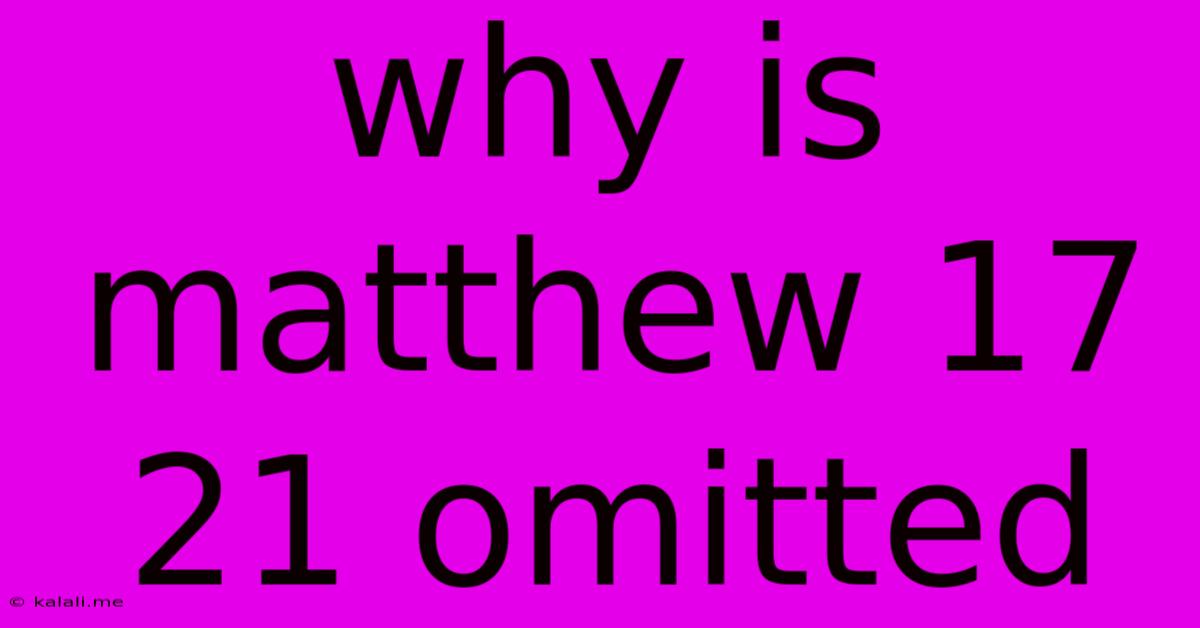Why Is Matthew 17 21 Omitted
Kalali
May 31, 2025 · 3 min read

Table of Contents
Why is Matthew 17:21 Omitted? Exploring the Missing Verse in Some Bibles
The question of why Matthew 17:21 is omitted from some Bible translations is a complex one, touching upon textual criticism, manuscript variations, and the ongoing process of biblical scholarship. This article will explore the reasons behind this omission, examining the different manuscript traditions and the implications for understanding the biblical text. This investigation will delve into the historical context surrounding the differing versions and offer a balanced perspective on the issue.
The Missing Verse: A Closer Look
The verse in question, Matthew 17:21, reads differently depending on the translation you consult. Many modern translations omit it entirely, while older translations include it. The missing verse typically discusses the ability of faith to cast out demons. The variations highlight the complexities involved in translating and interpreting ancient texts.
Textual Variants and Manuscript Evidence
The key to understanding the omission lies in the study of biblical manuscripts. Not all ancient copies of the Gospels agree perfectly. Scholars have identified numerous textual variants—differences between various manuscript copies—throughout the New Testament. Matthew 17:21 represents one such case.
Some manuscripts include the verse, while others don't. Scholars use a process called textual criticism to analyze these variants and determine which readings are most likely to reflect the original text. This involves considering factors like the age of the manuscripts, their geographical distribution, and the internal consistency of the text.
Why Some Manuscripts Lack Matthew 17:21
The absence of Matthew 17:21 in certain manuscripts suggests a few possible scenarios:
- Scribal Error: A scribe might have accidentally omitted the verse during the copying process. This is a common occurrence in the transmission of ancient texts.
- Harmonization: Some scribes may have intentionally removed the verse to harmonize Matthew's Gospel with other Gospels, aiming for consistency across the narratives.
- Theological Considerations: It's possible that in some theological contexts, the verse's message was deemed less important or potentially problematic, leading to its exclusion.
The Implications for Modern Translations
Modern Bible translations usually reflect the best scholarly judgment regarding textual variants. Translations that omit Matthew 17:21 often do so because textual analysis suggests that the verse is a later addition, not part of the original text. These translations aim for accuracy and fidelity to the earliest and most reliable manuscript evidence.
Navigating the Differences
The presence or absence of Matthew 17:21 doesn't necessarily undermine the overall message of the Gospel. The core teachings of Jesus and the significance of faith remain consistent regardless of this textual variation.
However, understanding the reasons behind the omission is crucial for appreciating the complexities of biblical scholarship and the ongoing work of interpreting ancient texts. It’s essential to consult reputable Bible translations and commentaries to gain a complete understanding of the context and various perspectives surrounding this particular verse. Remember that even with variations, the core message remains intact and encourages a continued study of the text.
Conclusion:
The question of Matthew 17:21's omission highlights the challenges and complexities in translating and interpreting ancient texts. While some translations include the verse and others omit it, the variations don't diminish the overall message of the Gospel. Understanding the underlying textual criticism provides a deeper appreciation for the meticulous work involved in bringing the Bible to modern readers. Ultimately, engaging with these differences encourages a more nuanced and informed understanding of the Bible's rich history and diverse manuscript traditions.
Latest Posts
Latest Posts
-
What Is Cud In The Bible
Jun 01, 2025
-
Car Heater Blows Hot Then Cold
Jun 01, 2025
-
Sum Of Two Uniform Random Variables
Jun 01, 2025
-
What Does U Stand For On A Circuti Board
Jun 01, 2025
-
How To Say Mommy In Japanese
Jun 01, 2025
Related Post
Thank you for visiting our website which covers about Why Is Matthew 17 21 Omitted . We hope the information provided has been useful to you. Feel free to contact us if you have any questions or need further assistance. See you next time and don't miss to bookmark.